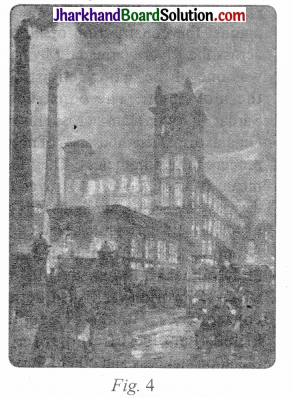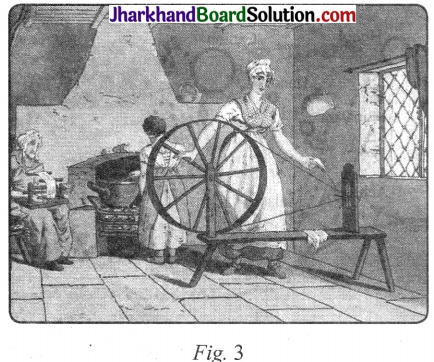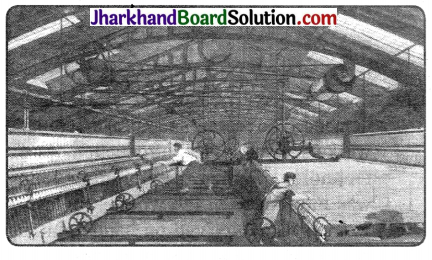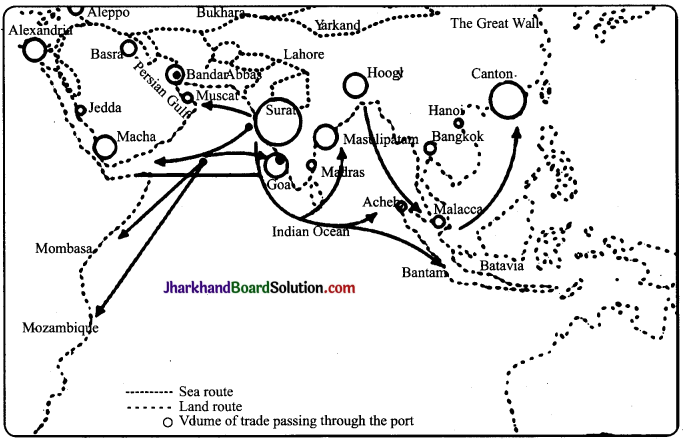JAC Board Class 10th Social Science Solutions History Chapter 4 The Age of Industrialisation
JAC Class 10th History The Age of Industrialisation InText Questions and Answers
Question 1.
Give two examples where modern development that is associated with progress has lead to problems. You may like to think of areas related to environmental issues, nuclear weapons or disease.
Answer:
The examples may vary from student to student. The Narmada Bachao Andolan is a social movement by human rights activists, environmentalists, adivasis and farmers against the construction of large dams across the River Narmada. Medha Patkar was one of the major activists leading the movement. The construction of Sardar Sarovar Dam across this river in Gujarat displaced thousands of people and rendered them homeless.
They lost their means of livelihood. It destroyed the bio¬diversity by destroying thousands of acres of forests and agricultural land.Dropping of atom bomb on Hiroshima and Nagasaki, Japan during the last stages of World War II had devastating consequences. Lakhs of people were killed. People suffered from burns, radiation sickness and other injuries.
Page 83
Question 2.
The way in which historians focus on industrialisation rather than on small workshops is a good example of how what we believe today about the past is influenced by what historians choose to notice and what they ignore. Note down one event or aspect of your own life which adults such as your parents or teachers may think is unimportant, but which you believe to be important.
Answer:
The answer may vary from student to student. Heavy tax and license fee should be levied on SUVs and heavy automobiles used for personal purpose. Usage of public transport should be encouraged. Public transport network should be improved. Taxes should be levied on keeping domestic pets. They should not litter the environment and surroundings. Fines should be imposed on littering public spaces by pets.
![]()
Question 3.
Look at Figs. 4 and 5. Can you see any difference in the way the two images show industrialisation? Explain your view briefly.


Answer:
Fig. 4 shows the cotton-spinning mill of Lancashire beautifully lighting up the city in the twilight with electricity. But Fig. 5 shows the negative aspects of industrialisation. Chimneys released smoke, the landscape is filled with dust and smoke from the industries.
Page 85
Question 4.
Imagine that you are a merchant writing back to a salesman who has been trying to persuade you to buy a new machine. Explain in your letter what you have heard and why you do not wish to invest in the new technology.
Answer:
From
Ram Nath Agarwal
Weaving Industries
Mumbai
To
Kashi Lai
Tools and Machines
Mumbai
Dear Kashi Lai
This is with reference to your letter with quotation of the price of the weaving machine. Looking at all the details and the situation, I am afraid I will not be able to purchase the machinery at present.
(i) The machine is too expensive and I do not have the amount to invest into it.
(ii) There are many labourers in my little factory and I would not like to lay them off. They are efficient.
(iii)As the work is seasonal, I can ask the workers to leave when the work is finished. However, the machine will remain unused and will have depreciation and maintenance costs.
(iv) The workers can create intricate designs and specific shapes. It is in demand by the upper class people who think that hand work symbolises refinement and class. However, the machine can only produce simple cloth. I hope you understand my situation and excuse me for the time being.
Thanking you Yours faithfully Ram Nath Agarwal
page 87
Question 5.
Look at Figs. 3, 7 and 11, then reread source B. Explain why many workers were opposed to the use of the Spinning Jenny.



A magistrate reported in 1790 about an incident when he was called in to protect a manufacturer’s property from being attacked by workers ‘From the depredations of a lawless Banditti of colliers and their wives, for the wives had lost their work to spinning engines … they advanced at first with much insolence, avowing their intention of cutting to pieces the machine lately introduced in the woollen manufacture which they suppose, if generally adopted, will lessen the demand for manual labour.
The women became clamorous. The men were more open to conviction and after some expostulation were induced to desist from their purpose and return peaceably home. J.L. Hammond and B. Hammond, The Skilled Labourer 1760-1832, quoted in Maxine Berg, The Age of Manufactures.
Answer:
Fig. 3 shows that each member of the household was involved in the production of yarn. One wheel moved only one spindle.Fig. 7 shows that giant wheels moved by steam power could set in motion hundreds of spindles to manufacture thread. It is clear from the picture that a single person could spin a large amount of thread. It would lead to unemployment.Fig. 11 is the Spinning Jenny, devised by James Hargreaves in 1764, speeded up the spinning process and reduced labour demand.
By turning one single wheel, a worker could set in motion a number of spindles and spin several threads at the same time. It was introduced in the woollen industry. Women who survived on hand spinning began attacking the new machine. The fear of unemployment made the workers hostile to the introduction of new technology.
![]()
Question 6.
On a map of Asia, find and draw the sea and land links of the textile trade from India to Central Asia, West Asia and Southeast Asia.

JAC Class 10th History The Age of Industrialisation Textbook Questions and Answers
Write in brief:
Question 1.
Explain the following:
(a) Women workers in Britain attacked the Spinning Jenny.
(b) In the seventeenth century merchants from towns in Europe began employing peasants and artisans within the villages.
(c) Thejjort of Surat declined by the end of the eighteenth century.
(d) The East India Company appointed gomasthas to supervise weavers in India.
Answer:
(a) The abundance of labour in the market affected the lives of workers. Many job seekers had to wait for weeks, spend nights under bridges or in night shelters. The Spinning Jenny speeded up the spinning process and reduced labour demand. The fear of unemployment made workers hostile to the introduction of new technology. When the Spinning Jenny was introduced in the woollen industry, women who survived on hand spinning began attacking the new machines.
(b) In the seventeenth century, merchants from towns in Europe began employing merchants and artisans within the villages because merchants could not expand their production within towns. The urban crafts and trade guilds were powerful. They were associations of producers that restricted entry of new people into the trade. It was therefore, difficult for new merchants to set up business in towns. So they turned to the countryside.
(c) (i) Before the age of machine and industries, silk and cotton goods from India dominated the international market in textiles. A vibrant sea trade operated through the main pre-colonial ports.
(ii) Surat on the Gujarat coast connected India to the Gulf and Red Sea Ports. A variety of Indian merchants and bankers were associated with in this network of export trade.
(iii) By 1750s, this network controlled by the Indians broke down and was gradually captured by the Europeans.
(iv) The Europeans first secured a variety of concessions from the local courts, then the monopoly rights to trade. This led to the decline of the old ports of Surat and Hoogly through which the local merchants had operated.
(v) From 16 million gross trade value at the end of the seventeenth century, it dropped to 3 million by the 1740s.
(d) (i) The East India Company developed a system of management and control that would eliminate competition, control costs and ensure regular supplies of cotton and silk goods.
(ii) They achieved this through a series of steps:
- The Company appointed a paid servant called the gomastha to supervise weavers, collect supplies, and examine the quality of cloth.
- A system of advance was started where the weavers were given loans to purchase the raw material for their production.
- This prevented the Company weavers from (jealing with other traders and they had to hand over the cloth produced only to the gomasthas.
Question 2.
Write True or False against each state- men#
(a) At the end of the nineteenth century, 80 per cent of the total workforce in Europe was employed in the technologically advanced industrial ” sector.
(b) The international market for fine textiles was dominated by India till the eighteenth century.
(c) The American Civil War resulted in the reduction of cotton exports from India.
(d) The introduction of the fly shuttle enabled handloom workers to improve their productivity.
Answer:
(a) False
(b) True
(c) False
(d) True
Question 3.
Explain what is meant by proto-industrialisation.
Answer:
Even before factories began to dot the landscape in England and Europe, there was large-scale industrial production for an international trade. This was not based on factories. Many historians now refer to this phase of industrialisation as proto-industrialisation.
NCERT ‘Discuss’ Questions
Question 1.
Why did some industrialists in the nineteenth-century Europe prefer hand labour over machines?
Answer:
Some industrialists in the nineteenth- century Europe preferred hand labour over machines because:
- The industrialists did not want to introduce machines which got the workers laid off and required large capital investment.
- Gas works and breweries needed more workers to meet the peak demand through the cold months.
- Book binders and printers, catering to Christmas demand, needed extra hands before December.
- At the waterfront, winter was the time that ships were repaired and spruced up.
- Industrialists preferred hand labour where the production fluctuated with the season.
- A range of products, especially goods with intricate designs and specific shapes, required only hand labour, and not mechanical technology.
- In Victorian Britain, the upper classes like the aristocrats and the bourgeoisie, preferred things produced by hand. It came to symbolise refinement and class.
Question 2.
How did the East India Company procure regular supplies of cotton and silk textiles from the Indian weavers?
Answer:
Once the East India Company established political power, it could assert a monopoly right to trade. It developed a system of management and control that would eliminate competition, control costs, and ensure regular supplies of cotton and silk goods.
(i) The Company tried to eliminate the existing traders and brokers connected with the cloth trade, and gain a more direct control the weaver. It appointed a paid servant called the gomastha to supervise weavers, collect supplies, and examine the quality of cloth.
(ii) Once the order was placed, the weavers were given loans to purchase the raw material for their production. This was known as system of advances. This binded the weavers to the gomastha. They had to hand over the cloth they produced to the gomastha. They could not take it to any other trader.
Question 3.
Imagine that you have been asked to write an article for an encyclopaedia on Britain and the history of cotton. Write your piece using information from the entire chapter.
Answer:
(i) The earliest factories in England came up by the 1730s. The factories multiplied by the late eighteenth century. The first symbol of the new era was cotton. The production expanded in the late nineteenth century. In 1760, Britain was importing 2.5 million pounds of raw cotton to feed its cotton industry. By 1787, this iftiport soared to 22 million pounds.
(ii) A series of inventions in the eighteenth century improved steps of the:
- production process (carding, twisting and spinning, and rolling). This enhanced the output per worker, enabling each worker to produce more, and they made possible the production of stronger threads and yam.
- Then Richard Arkwright created the cotton mill. The new model of the steam engine that was invented by Mathew Boulton was used in cotton and woollen industries.
(iii) Before the age of machine industries, silk and cotton goods from India dominated the international market in textiles.
- The European companies gradually gained the monopoly rights to trade by various strategies, and by 1750s, the Indian merchants lost their hold in the trade network.
- The Company eliminated the existing traders and workers connected with the cloth trade, and established a more direct control over the weaver.
- It appointed a paid servant, called the gomastha, to supervise weavers, collect supplies, and examine the quality of cloth. A system of advance was started to prevent the weavers from dealing with any other buyers.
- Once an order was placed, the weavers were offered loans to purchase cloth for their production, which in turn made them hand over the cloth only to the gomastha. They could not take it to any other trader.
(iv) As cotton industries developed in England, the East India Company sold British cotton goods in India. They were labelled MADE IN MANCHESTER to create a confidence in the customers about the quality of cloth.
(v) The situation changed during the First World War when the British mills produced goods to meet the needs of the army. Manchester imports into India declined. Even after the war, Manchester could not recover and recapture its old position in the Indian market,
(vi) The economy of Britain crumbled and it was unable to modernise and compete with the US, Germany and Japan.
![]()
Question 4.
Why did industrial production in India increase during the First World War?
Answer:
- During the First World War, the industrial growth was slow. When British mills got busy with war production to meet the needs of the army, Manchester imports into India declined.
- Suddenly, Indian mills had a vast home market to supply.
- As the war prolonged, Indian factories were called upon to supply war needs, such as jute bags, cloth for army uniforms, tents and leather boots, saddles for horse and mule, and a host of other items.
- New factories were set up and old ones ran multiple shifts. Many new workers were employed and everyone was made to work for longer hours. Over the war years, industrial production boomed.
NCERT ‘Project’ Work
Question 1.
Select any one industry in your region and find out its history. How has the technology changed? Where do the workers come from? How are the products advertised and marketed? Try and talk to the employers and some workers to get their views about the industry’s history.
Answer:
Self-help Hintst
- Seek the guidance of teachers, parents, elders in the community to find out about well-established industries in your region.
- If there is a chamber of commerce in your region, make an appointment and visit it to find about the industry you can study. Collect literature and survey materials on the industry narrowed down.
- Take a written appointment with the industry manager for a visit.
- Study the history of the industry, the structural and organisational changes over the years.
- Is it a large scale, small scale or a cottage industry?
- What products does it deal with? What does the industry produce?
- Find out the nature of workforce in the industry. Are they skilled or unskilled workers?
- Do the workers have any union? How is the relation between the management and workers?
- Study the imports and exports detail of the industry.
- How are their products marketed? What are the various means of advertising their products?
- How are they financed?
- Through all the above 11 questions, make a pattern through bar graphs, line graphs and various statistical methods to reflect the changes that have occurred in the industry.
- Development and progress of the industry may be shown through pictures, reports from journals, magazines, brochures, questionnaire surveys, etc.